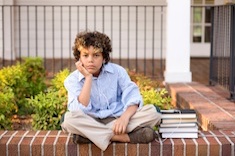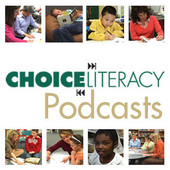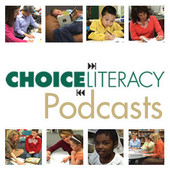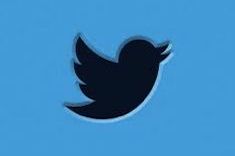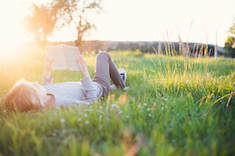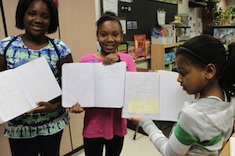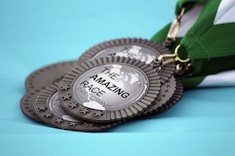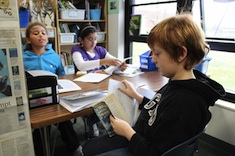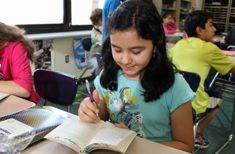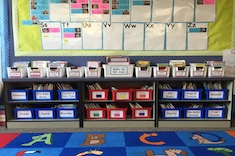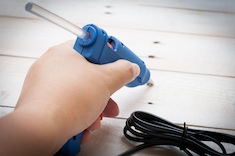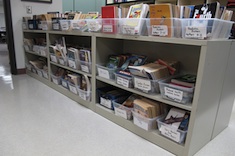Articles
Here is where you’ll find all the latest print features from our contributors. If you’d like to browse specifically by grade level, topic, or contributor, you can use the links in the right sidebar.
Latest Content
Making the Most of Small Groups with Jennifer Serravallo (PODCAST)
In this podcast, Jennifer Serravallo shares her “then” and “now” reflections about how guiding groups has evolved in her classroom.
Understanding Josh: The Audio Reader
Jennifer Schwanke tells the story of Josh, a special-needs student who is almost impossible to reach, until one committed teacher unlocks the key to what makes him tick as a learner.
Lester Laminack on Bullying (PODCAST)
In this podcast, Franki Sibberson chats with Lester Laminack about bullying. Lester is the author of beloved books for children and teachers including Saturdays and Teacakes and Unwrapping the Read Aloud
.
“Reinventing Language Every Time You Write” with Ralph Fletcher (PODCAST)
Ralph Fletcher recognizes that many teachers love language and explains how to bring that love of words to young writers.
Writing Models with Kelly Gallagher (PODCAST)
In this podcast, Kelly Gallagher reminds us of the power of the person right next to writers when they are learning the craft.
Putting the “Gradual” Back into Gradual Release of Responsibility
If it’s not sudden release of responsibility or no release of responsibility, what does gradual look like? Clare Landrigan and Tammy Mulligan bring this model to life.
New and Improved Nonfiction
Jennifer Schwanke remembers the days when mimeographed nonfiction pieces were rare and not welcome additions to elementary classrooms, and reflects on how much has changed.
#articleaday
Justin Stygles uses a daily nonfiction article activity as a way to build interest in nonfiction short texts, especially among reluctant readers in his classroom.
Tweets in the High School Classroom
Gretchen Schroeder finds that tweets are a terrific quick assessment tool for analyzing student understanding of everything from nonfiction texts to character development in classic literature.
The Professional Promise of Podcasts
Suzy Kaback discovers podcasts are invaluable for building her knowledge of social justice. She provides links to many of her favorite online sources to explore.
Writing for Reflection at the End of the Year
Katherine Sokolowski reflects on ways to extend the learning from an end-of-year activity all the way to the fall.
Making Plans for Summer Reading
Tara Barnett and Kate Mills begin a few days before the start of break to help students develop summer reading goals and plans.
Five Steps to Meaningful Formal Celebrations
Ruth Ayres gives a step-by-step process for closing out the school year with a meaningful writing celebration that welcomes the entire community
End-of-the-Year Reflection
Melanie Meehan shares a series of thoughtful questions to help students reflect on their process as writers, and what they need as they move into the summer and new classrooms.
Amazing Race
Gretchen Schroeder uses the format of the Amazing Race television show to help her high school students master materials for final exams and get moving throughout the school for a fun break.
Trying on Books for Reading Groups
Gigi McAllister finds taking time to have students browse texts before forming book clubs makes all the difference in the quality of the discussions.
Getting Teens Out of Reading Ruts: The Sampler
Carly Ullmer describes the activity she’s developed for getting her middle school readers out of reading ruts by sampling different authors and genres.
Graphic Novels for Beginning Readers
If you are looking to increase the quantity and quality of graphic novels for your learners in your classroom library, Shari Frost has a new booklist to get you started.
Gradual Release of the Library
Bitsy Parks explains how she designs her first-grade classroom library for “gradual release” throughout the school year in a way that allows students to build book-browsing skills.
Purposeful Partners
Tara Barnett and Kate Mills find the young learners in their classroom have mastered the art of turning and talking only with close friends. They provide practical suggestions for expanding the circle of peer response.
Hot Glue Guns
Mary Lee Hahn considers the use of Hot Glue Guns in her classroom, and moves from exasperation to appreciating the learning happening when we think kids are just messing around with peers and the tools we've given them.
Culturally Responsive Texts
Katrina Edwards is horrified when a student response reveals cultural gaps in her first-grade classroom library. She researches possibilities for expanding the diversity of texts, and shares an annotated bibliography to download linking different cultures and curricular possibilities.
Adjusting the Classroom Library for Student Needs
Mandy Robek realizes her classroom library isn’t working for her second graders, in part because many of the books are still too difficult for students early in the year. She explains her process of sorting and stowing books for later use.
Choosing and Refining Student Goals
Katie DiCesare shares the process of having her first graders choose their literacy goals, and her role in helping them refine goals through observation and conferring.
A Place to Belong
Andrea Smith reflects on preparing to say goodbye to students and her teaching partner of many years. If you have a favorite colleague who is retiring, you may want to get a hankie ready before you read this one.
Revising Weekly Reflections
Katherine Sokolowski revises the weekly reflection form her fifth graders use to ensure everyone is tracking goals, progress, and expectations.
Alternatives to Daily Editing as a “Bell-Ringer” Activity
The “daily edit” is a common routine in many classrooms. Shari Frost explains why this may not be an effective way to teach conventions, and offers some alternatives.
An Individualized Conventions Checklist
Melanie Meehan finds that a flexible conventions checklist that students develop according to their own needs is the best way to ensure conventions are taught in the context of authentic student work.
Deep Reading of Picture Books in Middle School
Christy Rush-Levine shows the power of using picture books with young adolescents to model close reading and deepen comprehension of sophisticated texts.
The Beauty of Imitation
Jennifer Schwanke explains how concerns about plagiarism can get in the way of recognizing the value of mimicking the styles of other writers to find our own.
Browse Content By
Type
Category
- Assessment Tools
- Big Fresh Archives
- Booklists
- Choice Numeracy
- Classroom Design
- Common Core
- Community Building
- Conferring
- Content Literacy
- Digital Literacy
- English Language Learners
- Equity
- Family Relations
- Free Samples
- Guiding Groups
- Leadership
- Literacy Coaches
- Mentor Texts
- Minilessons
- New Teacher Mentors
- Podcasts
- Poetry
- Quote Collections
- Reading Strategies
- Self Care
- Struggling and Striving Learners
- Talking and Listening
- Teacher Study Groups
- Teaching Reading
- Teaching Writing
- Word Study and Vocabulary
Author
- Melissa Quimby
- Nawal Qarooni
- Gwen Blumberg
- Julie Cox
- The Lead Learners
- Hannah Tills
- Josie Stewart
- Ruth Metcalfe
- Mallory Messenger
- Becca Burk
- Jodie Bailey
- Vivian Chen
- Mary Brower
- Tiffany Abbott Fuller
- Stephanie Affinito
- Ruth Ayres
- Leigh Anne Eck
- Heather Fisher
- Shari Frost
- Julie Johnson
- Suzy Kaback
- Gigi McAllister
- Shirl McPhillips
- Melanie Meehan
- Cathy Mere
- Debbie Miller
- Tara Barnett and Kate Mills
- Tammy Mulligan
- Dana Murphy
- Bitsy Parks
- David Pittman
- Brenda Power
- Heather Rader
- Matt Renwick
- Mandy Robek
- Christy Rush-Levine
- Gretchen Schroeder
- Jen Schwanke
- Brian Sepe
- Katherine Sokolowski
- Stella Villalba
- Jennifer Vincent
Grade Level
Choice Literacy Membership
Articles
Get full access to all Choice Literacy article content
Videos
Get full access to all Choice Literacy video content
Courses
Access Choice Literacy course curriculum and training


